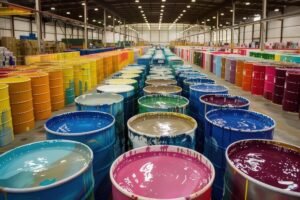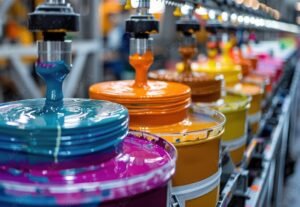Introduction to Gujarat’s Paint Industry
The paint manufacturing sector in Gujarat has witnessed remarkable growth over the past few decades, establishing itself as a dominant force in the Indian economy. Renowned for its industrial capabilities, Gujarat has become a hub for high-capacity paint production, catering to both domestic and international markets. This evolution is largely driven by the state’s favorable regulatory environment, robust infrastructure, and a skilled workforce, all of which contribute to the efficiency and growth of the industry.
Current market trends indicate a rising demand for specialty paints, eco-friendly products, and innovative coatings, which has consequently prompted manufacturers to invest in high-capacity production facilities. These developments not only aim to fulfill domestic requirements but also to tap into global market opportunities, positioning Gujarat as a significant player on the international stage. Additionally, the diverse range of paints produced, including industrial, decorative, automotive, and protective coatings, enables the sector to cater to various industries such as construction, automotive, and manufacturing.
The importance of high-capacity paint manufacturing in Gujarat cannot be overstated. As consumer preferences shift towards more sustainable and high-quality products, manufacturers are compelled to enhance their production capabilities to meet these evolving needs. This includes investing in advanced technologies and processes that enable the production of specialized paints, improving both efficiency and product quality. Furthermore, Gujarat’s contribution to the national economy is profound, as it not only contributes to employment generation but also plays a key role in fulfilling the growing demand for paints across various sectors.
In summary, Gujarat’s paint industry is characterized by its rapid growth, diverse product offerings, and significant contributions to both the national and global markets. High-capacity production is essential in meeting the increasing demands for innovative and sustainable paint solutions, solidifying Gujarat’s standing as a leader in the Indian paint manufacturing landscape.

Historical Context of Paint Manufacturing in Gujarat
The history of paint manufacturing in Gujarat dates back to the early 20th century when the region began to emerge as an industrial hub in India. The establishment of the first paint companies during this period marked the beginning of a significant transformation in local manufacturing practices. Early ventures focused primarily on producing traditional paints utilizing natural pigments and materials, which were common in domestic applications.
As the years progressed, Gujarat experienced economic developments that prompted the establishment of more sophisticated manufacturing techniques. The introduction of synthetic pigments and modern chemical processes in the 1960s and 1970s played a pivotal role in this evolution. Painted surfaces transitioned from simple color applications to more durable and functional coatings, catering to both residential and industrial markets. This shift also gave rise to innovative formulations that enhanced the performance of paints, spurring further interest from manufacturers and consumers alike.
The regional infrastructure began to support larger-scale operations due to strategic investments in transportation, energy, and technology. Major paint manufacturers recognized the potential for high-capacity production based on the abundant availability of raw materials and skilled labor in Gujarat. Consequently, the state’s industrial policies and incentives further encouraged the growth of paint companies, leading to the establishment of numerous enterprises focused on fulfilling both national and international demands.
Over the decades, Gujarat has solidified its position as a leading paint manufacturing hub in India. The local industry is characterized by a blend of traditional craftsmanship and modern innovation, with companies continually adapting to shifting market trends and consumer preferences. As a result, Gujarat’s historical growth trajectory has set the foundation for today’s high-capacity paint production, positioning the state for continued advancements in the industry.
Technological Advancements in Manufacturing Processes
In the ever-evolving landscape of paint manufacturing, technological advancements play a pivotal role, particularly in Gujarat, where the industry has witnessed transformative changes. The introduction of state-of-the-art machinery has significantly uplifted the production capabilities of paint manufacturers. For instance, companies are increasingly investing in modern mixing and milling equipment that provides superior dispersion of pigments, leading to improved color consistency and product quality. These sophisticated machines reduce production time and enhance the overall efficiency of the manufacturing processes.
Furthermore, the adoption of automated production lines has revolutionized operations within paint manufacturing facilities. Automation not only streamlines the production procedures but also minimizes human error, thereby improving product reliability. Robotics are now employed in various stages, including filling, packaging, and labeling, which optimizes output capacity while ensuring precision. This technology also allows manufacturers to scale operations effectively, accommodating fluctuating market demands without compromising quality.
Another significant advancement is the integration of data analytics and IoT (Internet of Things) into manufacturing processes. By leveraging these technologies, manufacturers can monitor equipment performance in real-time, conduct predictive maintenance, and analyze production data to identify areas for optimization. This analytical approach not only reduces downtime but also enhances decision-making and operational efficiency. Moreover, it contributes to sustainable practices by enabling manufacturers to reduce waste and energy consumption during production.
Overall, the advancements in machinery, automation, and data analytics in Gujarat’s paint manufacturing sector have substantially improved efficiency, quality, and output capacity. As manufacturers continue to innovate and adopt cutting-edge technologies, the future of high-capacity paint production appears promising, ensuring that they remain competitive in the ever-demanding market of industrial coatings and decorative paints.

Key Players in Gujarat’s High-Capacity Paint Manufacturing
Gujarat is home to a robust ecosystem of companies active in high-capacity paint manufacturing, featuring a mix of established industry giants and innovative newcomers. These players are instrumental in shaping the dynamics of the paint industry, primarily due to their substantial market share, diverse product ranges, and competitive strategies.
One of the foremost companies in this sector is Asian Paints, which has maintained its dominance through consistent innovation and a formidable distribution network. The company offers an extensive range of products, including decorative paints, industrial coatings, and automotive finishes, addressing both consumer and commercial needs. Their investment in research and development facilitates the introduction of eco-friendly and technologically advanced solutions, ensuring they remain at the forefront of the market.
Another significant player is Berger Paints, a well-established brand known for its high-quality paint offerings and considerable market presence in Gujarat. With a range that encompasses both exterior and interior paints, Berger Paints also emphasizes sustainability, recently launching products that reduce environmental impact. Their competitive strategy often revolves around strategic partnerships and an emphasis on customer service, enhancing their market penetration and brand loyalty.
In addition to these giants, Gujarat has witnessed the emergence of several smaller companies making impactful contributions to the high-capacity paint landscape. Noteworthy among these is Nippon Paint, which has quickly gained recognition for its innovative products tailored to the local market. Their aggressive marketing tactics and emphasis on quality have positioned them as formidable competitors.
Overall, the interplay between established and emerging players drives diversity and competition in Gujarat’s high-capacity paint manufacturing sector, fostering both economic growth and innovation within the industry.

Supply Chain and Raw Material Sources
The supply chain of the paint manufacturing industry in Gujarat plays a pivotal role in ensuring high-capacity production. To create high-quality paints, manufacturers rely on a variety of raw materials, including pigments, solvents, resins, and additives. These materials can be sourced both locally and internationally, depending on the specifications and quality requirements. Local suppliers often provide convenient access to essential raw materials, thus shortening lead times and reducing logistical costs. The proximity of raw material sources also enables manufacturers to respond swiftly to any fluctuations in demand.
However, the dependency on local suppliers comes with its own set of challenges, including variability in quality and availability. To mitigate these issues, some manufacturers have developed strategic partnerships with reliable suppliers. On the other hand, international sources offer a broader range of specialty materials that can enhance product performance but introduce complexity to the supply chain due to longer lead times and potential import tariffs.
Logistical challenges also significantly impact the supply chain dynamics in Gujarat’s paint sector. Transportation infrastructure, which includes road networks and ports, plays a critical role in the timely delivery of raw materials to manufacturing facilities. The efficiency of logistics can affect production schedules; any disruptions in transportation can lead to delays, ultimately impacting output levels and profitability. Additionally, fluctuating fuel prices and governmental regulations concerning transportation can further exacerbate these challenges.
Moreover, the ongoing transition towards sustainable practices in the paint industry necessitates a reevaluation of raw material sourcing. An increasing number of companies are seeking eco-friendly alternatives, which may require new supplier relationships and adjustments in inventory management. This trend underscores the importance of a resilient supply chain that can adapt to both market demands and regulatory pressures.
Government Policies and Regulatory Framework
Gujarat has gained recognition as a crucial hub for paint manufacturing due to its favorable government policies and supportive regulatory framework. These initiatives aim to enhance the sector’s capacity while adhering to environmental standards and promoting sustainable practices. One of the notable constructs is the Gujarat Industrial Policy, which provides various incentives for high-capacity paint production. These include capital investment subsidies and tax exemptions for manufacturers who commit to expanding their operational capacity. Such policies encourage businesses to innovate and upgrade their manufacturing processes to align with the growing demand for high-quality paints.
Furthermore, the state government has instituted various programs specifically designed to advance sustainable manufacturing practices within the paint industry. For instance, the Gujarat Pollution Control Board (GPCB) enforces stringent environmental regulations that necessitate the reduction of hazardous waste outputs and the minimization of volatile organic compounds (VOCs) in paint formulations. Compliance with these regulations not only fosters a cleaner environment but also enhances the reputation of manufacturers adhering to best practices in sustainability.
In addition to environmental regulations, the government actively promotes research and development initiatives aimed at reducing the ecological footprint of paint production. This includes funding for projects that explore alternative formulations and eco-friendly raw materials, thus steering the industry towards greener technologies. The alignment of state policies with national environmental agendas further facilitates innovation, allowing Gujarat to remain competitive on both national and international fronts.
Collectively, the combination of incentives for capacity enhancement, rigorous environmental regulations, and support for sustainable initiatives creates a robust ecosystem for high-capacity paint manufacturing in Gujarat. Such a strategic approach not only benefits the local economy but also addresses the global demand for more sustainable industrial practices.
Market Demand and Export Opportunities
The paint manufacturing industry in Gujarat has shown remarkable growth in recent years, driven primarily by increasing domestic and global demands for high-capacity paint products. The surge in construction activities, coupled with a booming real estate sector, has significantly contributed to the rising consumption of paints in the domestic market. According to industry reports, there has been an observed increase in the demand for decorative and protective paints, which has prompted manufacturers to enhance their production capabilities. As a result, Gujarat stands out as a pivotal player in meeting these requirements due to its established manufacturing infrastructure.
On the international front, the export of high-capacity paints from Gujarat presents significant opportunities. The region’s manufacturers are strategically positioned to export their products to emerging markets in Southeast Asia, the Middle East, and Africa, where demand for quality paint products continues to grow. The increasing awareness about eco-friendly and sustainable paint solutions also opens new avenues for manufacturers willing to innovate and adapt to international standards. With the Indian government’s push towards “Make in India,” exporters are now receiving enhanced support, including financial incentives that aim to boost exports further.
Despite the promising landscape, manufacturers encounter several challenges that inhibit the full realization of export potential. These include stringent compliance regulations, fluctuating raw material costs, and intense competition from established players in alternative manufacturing hubs. Adapting to technological advancements and consumer preferences in various markets is also crucial. Nevertheless, addressing these challenges effectively while leveraging Gujarat’s favorable manufacturing environment can lead to substantial growth in both domestic and export demands for paint products.

Sustainability Practices in High-Capacity Manufacturing
The paint manufacturing industry in Gujarat is increasingly embracing sustainability practices to mitigate its environmental impact while maintaining efficiency and productivity. High-capacity manufacturing, essential for meeting the growing demand for paint products, must therefore integrate eco-friendly processes that adhere to environmental regulations and promote resource conservation. A significant shift has been observed towards renewable energy sources, with many manufacturers investing in solar and wind energy to power their operations. This transition not only results in a reduced carbon footprint but also aligns with governmental initiatives aimed at promoting green energy use.
In addition to harnessing renewable energy, paint manufacturers in Gujarat are adopting advanced technologies that facilitate the use of sustainable raw materials. Innovations such as bio-based pigments and solvents are gaining traction, significantly lowering the toxicity levels associated with traditional chemical processes. Moreover, companies are investing in research and development to create products with lower volatile organic compounds (VOCs), which contribute to air pollution and adverse health effects. This commitment to producing environmentally friendly products demonstrates a proactive approach in addressing the needs of more conscious consumers.
Waste management is another critical area where sustainable practices are being implemented effectively. Comprehensive strategies are being established to minimize waste generation during manufacturing processes, with an emphasis on recycling and reusing materials whenever possible. For instance, water used in production can be treated and reused, significantly reducing overall water consumption. Furthermore, the industry is evaluating the full lifecycle of paint products, promoting take-back programs that encourage consumers to return empty containers for proper disposal and recycling.
Gujarat’s paint manufacturing sector showcases a growing commitment to sustainability through the adoption of eco-friendly production processes, waste management strategies, and innovative technologies. As these practices continue to evolve, they will play a pivotal role in transforming the high-capacity manufacturing landscape, ensuring that environmental stewardship remains at the forefront of the industry’s development.
Future Trends in Gujarat’s Paint Industry
The paint manufacturing sector in Gujarat is on the cusp of significant transformation, propelled by various trends anticipated to reshape the landscape. First and foremost, the escalating demand for eco-friendly and sustainable paint products is a defining characteristic of upcoming market shifts. Consumers are increasingly prioritizing environmentally responsible options, prompting manufacturers in Gujarat to innovate in the development of low-VOC (volatile organic compounds) and biodegradable paints. This shift not only aligns with global sustainability goals but also meets the growing regulatory pressures for greener solutions.
In addition, advancements in technology are set to revolutionize the production processes within the paint industry. With the rise of automation and smart manufacturing, companies are expected to implement state-of-the-art technologies to streamline operations, enhance efficiency, and reduce production costs. Digital tools such as AI and IoT are becoming integral, enabling real-time monitoring and data analytics to significantly improve operational performance and predict market trends accurately.
Furthermore, the evolution of consumer preferences is shaping the paint manufacturing landscape in Gujarat. There is a noticeable trend towards customization, wherein consumers seek personalized solutions that cater to their specific needs and tastes. This increasing demand for tailored products presents an opportunity for manufacturers to differentiate themselves in a competitive marketplace, possibly leading to the introduction of bespoke colors and finishes.
Logistically, the expansion of the construction sector in Gujarat is expected to drive paint consumption significantly. As urban development continues to surge, the subsequent rise in residential and commercial projects will bolster the demand for high-capacity paint manufacturing. This interplay of consumer trends, technological advancements, and market demand highlights the dynamic nature of Gujarat’s paint industry, steering it toward a promising future.

